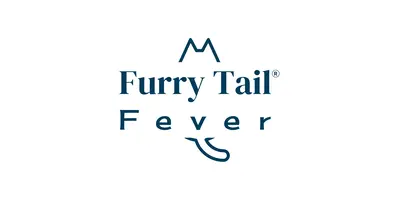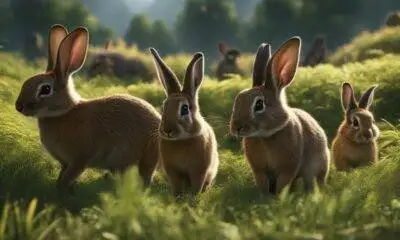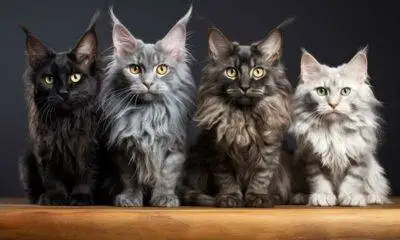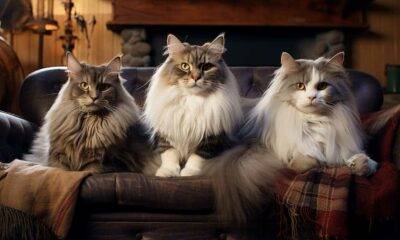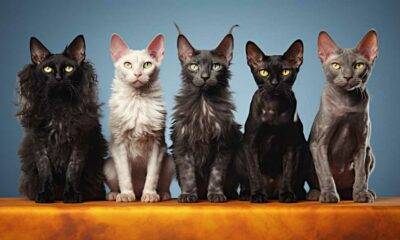Cat Breeds
14 Lesser-Known Domestic Cat Breeds: A Fascinating Collection

14 Lesser-Known Domestic Cat Breeds: A Fascinating Collection
Welcome to the fascinating world of domestic cats!
In this collection, we’ll explore 14 lesser-known cat breeds that are sure to spark your curiosity.
From the graceful Turkish Van to the adorable Minskin, each breed possesses its own unique traits and characteristics.
Whether you’re a cat lover or simply looking to expand your knowledge, this compilation provides a captivating glimpse into the diverse world of domestic felines.
So, find a comfortable spot, prepare to be intrigued, and embark on an enchanting journey through the realm of these extraordinary cat breeds.
Key Takeaways
Uncover the Beauty of Lesser-Known Domestic Cat Breeds
You may be familiar with popular cat breeds like the Maine Coon or the Siamese, but there is a fascinating collection of lesser-known domestic cat breeds waiting to be discovered. These breeds may not be as well-known, but they offer a diverse range of characteristics and charm.
One such breed is the Turkish Van, known for its majestic appearance and love for water. These cats have a unique story to tell, and their striking looks are sure to capture your attention.
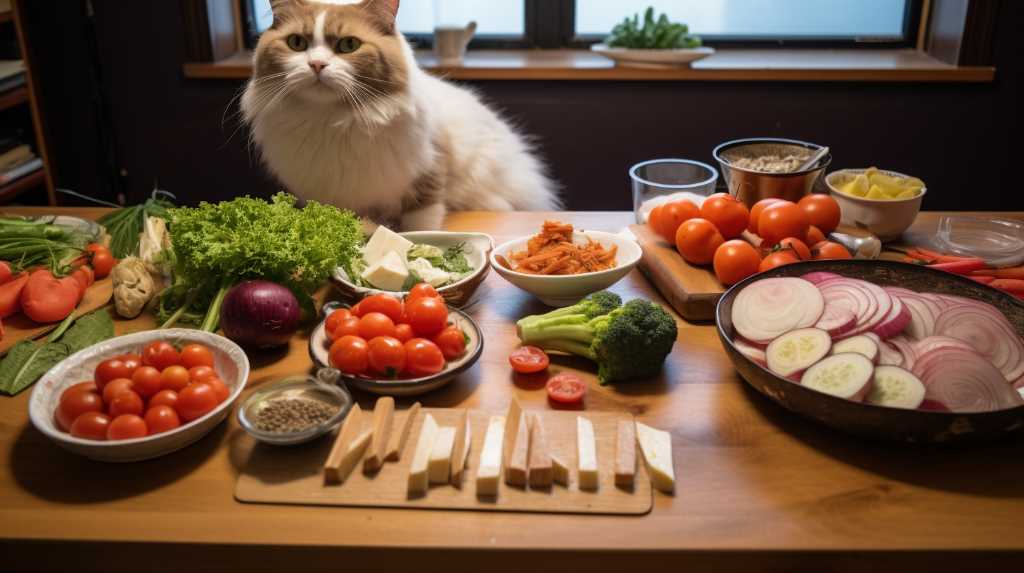
Another lesser-known breed is the Minskin, which stands out for its adorable short legs and hairless body. Each breed has its own distinct features and qualities that make them truly special.
It’s important to remember that cats are more than just cute companions. They are living beings with their own rich histories and characteristics. By exploring these lesser-known breeds, you can expand your understanding of feline beauty and the wide variety of cats that exist in the world.
So, next time you come across a cat, take a moment to appreciate the hidden gems of the feline world. You never know what treasures you might uncover when you keep an open mind and embrace the lesser-known breeds.
Understanding Feline Genetics
If you’re interested in learning about the unique traits of lesser-known domestic cat breeds, understanding feline genetics can provide valuable insights into their distinctive physical and behavioral characteristics.
Genetic mutations in cat breeds play a significant role in shaping the appearance and temperament of felines. These mutations, resulting from changes in the genetic code, lead to the development of specific traits that distinguish one breed from another.
Selective breeding by breeders has played a crucial role in feline genetics. They’ve carefully chosen cats with desired characteristics, such as coat color, pattern, length, and personality traits, to pass on these qualities to future generations. This has resulted in certain genetic traits becoming more common in particular cat breeds, contributing to the unique features we see today.
Understanding feline genetics not only helps us understand the physical attributes of cat breeds but also provides insight into their behavior and predispositions. This knowledge is invaluable for cat owners as it helps them understand and meet the specific needs of their feline companions.
Now, let’s explore the fascinating world of the Turkish Van breed.

Turkish Van
Let’s explore the unique characteristics and history of the Turkish Van breed, known for its striking coat pattern and distinct traits.
The Turkish Van is a fascinating breed, renowned for its love of water and exceptional swimming abilities. Here are some key points about the Turkish Van:
- The Unique Swimming Abilities of the Turkish Van:
Turkish Vans are often called ‘swimming cats’ because they have a special affinity for water. Unlike most other feline breeds, they enjoy playing and swimming in pools, ponds, and even the sea. - The History and Folklore Surrounding the Turkish Van Breed:
According to legend, the Turkish Van breed is said to have descended from the ancient cats that were on Noah’s Ark. It is believed that they survived a great flood by swimming to shore. This captivating folklore adds to the mystique and allure of this exceptional breed. - Distinctive Physical Characteristics:
One of the most noticeable features of the Turkish Van is its semi-longhaired coat, which has a unique color pattern of white with colored markings on the head and tail. Additionally, their eyes often have mismatched colors, further enhancing their distinctive appearance.
Moving on to the next intriguing breed, let’s explore the remarkable characteristics of the American Wirehair.
American Wirehair
The American Wirehair is a unique and relatively rare breed of domestic cat. What sets them apart is their distinctive wiry coat. When it comes to grooming, it’s important to keep in mind that their coat requires minimal maintenance. Simply brushing their coat once a week is usually sufficient to keep it in good condition. To prevent their wiry hairs from breaking, it’s best to use a rubber brush or a grooming glove.
Apart from their unique coat, American Wirehairs are also known for their friendly and affectionate nature. They make wonderful companions and are often playful and curious, seeking interaction with their human family members. This breed is adaptable and easygoing, making them well-suited for various living situations. When it comes to grooming, their cooperative nature makes the process easier.
Understanding the grooming needs and personality traits of the American Wirehair is essential for ensuring a happy and healthy life for your feline friend. Keep their coat well-maintained and enjoy the companionship and love they bring to your home.
LaPerm
LaPerm cats have a unique curly coat that distinguishes them from other domestic breeds. Their charming curls come in different lengths and textures, adding elegance to their appearance. There are short-haired LaPerms with tight curls, as well as long-haired LaPerms with flowing locks, providing a range of coat variations. Each cat has a beautiful and individual coat, making them a delightful addition to any home.
In terms of personality, Laperms are known for being affectionate and outgoing. They enjoy the company of their human companions and often seek out a warm lap to curl up on. These intelligent and playful cats also love interactive games and toys that engage their curious minds. With their gentle and loving nature, LaPerms make ideal pets for individuals or families looking for a devoted and affectionate companion.
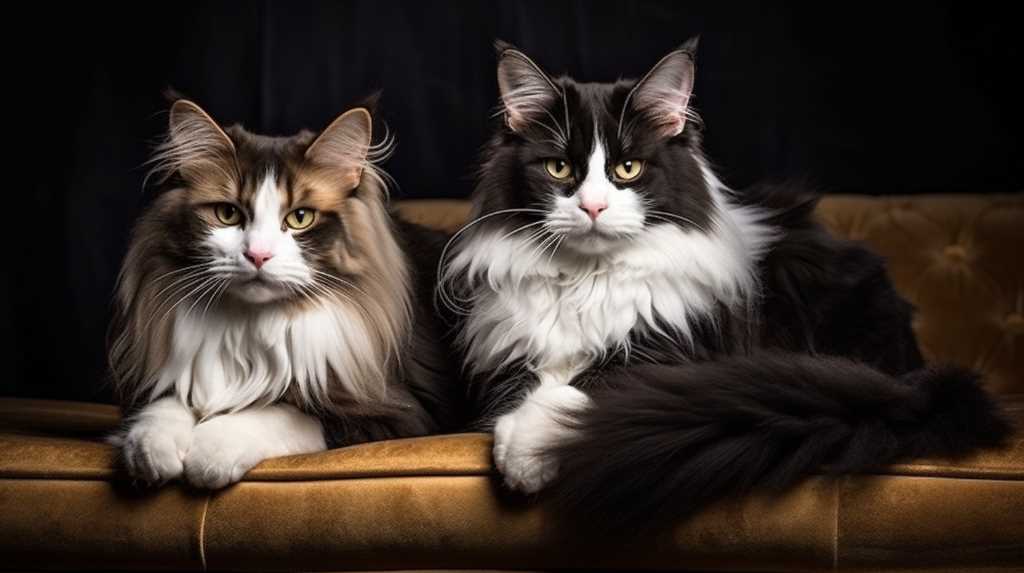
Sokoke
When considering adding a unique and intriguing feline companion to your home, the Sokoke breed might catch your attention.
Originating from the Arabuko Sokoke forest in Kenya, the Sokoke cat is a natural breed known for its wild appearance and striking coat pattern. With distinctive tabby markings and an agile build, this breed can be a fascinating addition to any household.
The Sokoke cat is renowned for its friendly and sociable nature. It forms strong bonds with its human companions and enjoys being involved in daily activities. These intelligent and active cats have a playful demeanor and curiosity, often seeking out new experiences and interactions.
Their adaptability and easy-going temperament make them well-suited for families and individuals looking for a devoted and entertaining pet.
Serengeti
The Serengeti breed of domestic cats originates from the African continent. They’ve a unique and majestic appearance, resembling their wild ancestors. If you’re considering adding a Serengeti cat to your family, it’s important to understand their characteristics and temperament.
Here’s what you need to know:
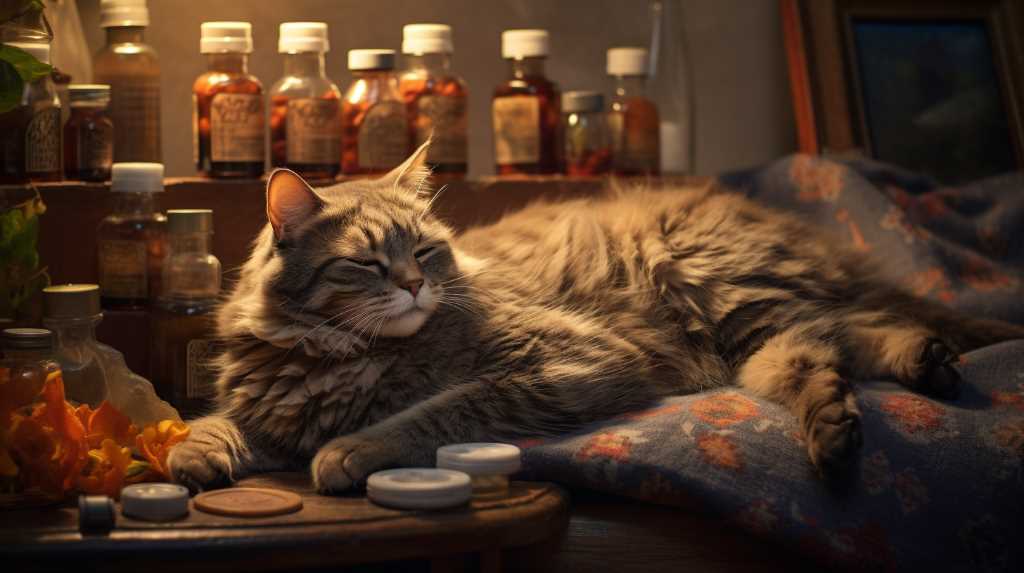
- Serengeti Cat Characteristics:
- Sleek and Elegant: Serengeti cats have a slender and athletic build with long legs, giving them a graceful stature.
- Exotic Appearance: Their coat features a beautiful spotted pattern, similar to the African serval, which adds to their exotic allure.
- Energetic and Agile: Serengeti cats are known for their high energy levels and exceptional agility, making them skilled hunters and playful companions.
- Serengeti Cat Temperament:
- Affectionate and Social: Despite their wild appearance, Serengeti cats are affectionate and enjoy the company of their human family members.
- Intelligent and Curious: These cats are highly intelligent and curious, often seeking mental and physical stimulation through interactive play and puzzle toys.
- Loyal and Devoted: Serengetis form strong bonds with their owners and display loyalty and devotion in their interactions.
Considering these traits is important when deciding to bring a Serengeti cat into your home, as they may require a specific environment and level of engagement.
Peterbald
The Peterbald breed is known for its unique appearance and charming personality, making it a delightful addition to any feline family. This elegant and affectionate breed stands out for its lack of coat or short coat, as well as its friendly and social nature. If you’re thinking about bringing a Peterbald into your home, here are some essential grooming tips and personality traits to keep in mind:
Grooming Tips for Peterbalds:

- Regular baths are important to manage their skin oils since they don’t have much fur.
- Brushing their coat, if they’ve one, helps distribute natural oils and maintain healthy skin.
- Since Peterbalds lack a protective coat, they may need sunblock when outdoors to prevent sunburn.
Personality Traits of Peterbalds:
- Peterbalds are highly social and enjoy the company of people and other pets.
- They’re known for their intelligence and can be trained to do tricks or walk on a leash.
- Peterbalds are often described as playful, curious, and highly energetic.
Cymric
If you’re thinking about adding a Cymric cat to your family, get ready for a delightful and affectionate companion with a unique long-haired coat. The Cymric is closely related to the Manx breed and is known for its playful and loyal nature.
Here’s what you should know about their personality traits and grooming requirements:
- Cymric Personality Traits
- Affectionate: Cymrics are known for their loving and affectionate nature. They form strong bonds with their human family members and enjoy participating in daily activities.
- Playful: Despite their dignified appearance, Cymrics are playful cats that love interactive play sessions. They’re curious and intelligent, thriving on mental stimulation.
- Loyal: Cymrics are fiercely loyal to their human companions and enjoy being by their side. They make excellent companions for those looking for a devoted feline friend.
- Cymric Grooming Needs
- Coat Maintenance: Due to their long-haired coats, Cymrics require regular grooming to prevent matting and tangles. Brushing their coat a few times a week is necessary to keep it in good condition.
- Health Check: Regular grooming sessions provide an opportunity to check for any skin issues or abnormalities. It’s important to monitor their overall health during grooming.
- Nail Care: Regular nail trimming is essential to maintain healthy nail length and prevent any discomfort or paw problems.
When considering adding a Cymric to your family, remember their affectionate nature and grooming needs to ensure a happy and healthy life for your new feline friend.
Kurilian Bobtail
Considering adding a Kurilian Bobtail to your family? This breed of cat is known for its unique physical traits, such as a short, strong, and kinked tail resembling a pom-pom, and a semi-cobby body with powerful hindquarters. Originating from the Kuril Islands and the Russian Far East, the Kurilian Bobtail is a sturdy and adaptable cat with strong hunting instincts.
The Kurilian Bobtail’s distinct features can be attributed to the natural selection process on the Kuril Islands. Only the most adaptable and resourceful cats survived the harsh conditions, leading to the development of this breed.
Taking care of a Kurilian Bobtail involves providing ample space for them to exercise their natural hunting instincts and mental stimulation to keep their agile minds engaged. These cats are loyal and intelligent companions who thrive on interaction with their human family members. If you’re looking for a cat that combines a touch of wilderness with a loving nature, the Kurilian Bobtail could be the perfect addition to your home.
Chartreux
Thinking about adding a Chartreux to your family? This ancient breed, known for its unique appearance and gentle temperament, could make a wonderful addition to your home.
Here’s what you need to know:

Origin and History
The Chartreux is believed to have originated in France, with documented records dating back to the 16th century. Legend has it that these cats were raised by the Carthusian monks of the Le Grand Chartreux monastery, which is where they got their name and mysterious aura. Although the breed faced near extinction during World War II, dedicated breeding programs helped revive them.
Physical Characteristics
Chartreux cats are known for their medium-sized bodies and stunning blue-gray coats that are dense and water-repellent. Their captivating orange or copper eyes, rounded heads, sweet expressions, and unique smile-shaped noses make them easily recognizable. These cats are highly intelligent and adaptable, often described as having dog-like loyalty and affectionate nature.
With their fascinating history and captivating appearance, a Chartreux could be the perfect feline companion for your family.
Caracal
Interested in adding a unique and exotic breed to your family? Continuing from the fascinating history of the Chartreux, the Caracal is a captivating and lesser-known domestic cat breed worth exploring.
Caracals are visually striking with their distinctive tufted ears and sleek, tawny fur. These medium-sized cats are known for their agility and impressive appearance. Caracals are often described as confident, independent, and intelligent. They’ve a strong prey drive and are skilled hunters, making them active and playful companions.
Caracals possess unique characteristics, including their impressive jumping abilities. They’re excellent climbers and can leap to astonishing heights to catch their prey. Their strong and muscular build reflects their natural athleticism.
In terms of behavior, caracals are known for their curiosity and assertiveness. They’re attentive and may form a strong bond with their human family members. However, they also appreciate their independence and require plenty of mental and physical stimulation. Understanding their energetic nature and providing engaging activities can help ensure a harmonious relationship.
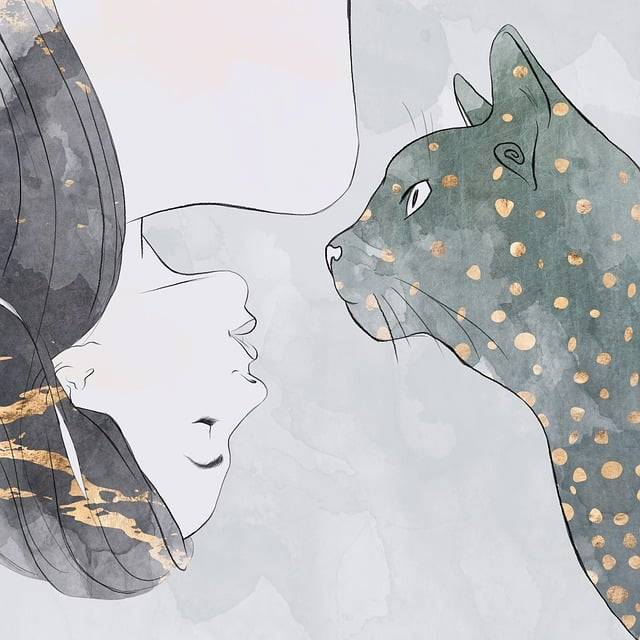
If you’re ready for a lively and inquisitive feline companion, the caracal might be the perfect addition to your household.
Minskin
If you’re considering adding a unique and charming cat to your family, Minskin cats are worth your attention. These adorable felines possess endearing characteristics that make them a delightful choice as pets.
Here’s what you should know about Minskin cats:
- Minskin Characteristics:
- Minskin cats are small to medium-sized and are known for their short legs and expressive eyes.
- Their coat can come in various colors and patterns, and it has a soft, velvety texture that’s irresistible to touch.
- Minskins are sociable and affectionate, enjoying the company of their human family members as well as other pets.
Minskin Origin and History:
- The Minskin breed was developed in Boston, Massachusetts, in 1998 by crossing Munchkin, Burmese, and Sphynx cats.
- Their unique appearance and friendly demeanor have quickly made them popular among cat enthusiasts worldwide.
- Despite their short legs, Minskins are agile and love to play, making them entertaining and loving companions for any household.
With their adorable looks and affectionate nature, Minskin cats are sure to bring joy to your home.
As we move on to the next breed, let’s explore the fascinating world of ‘ojos azules’.
Ojos Azules
Ojos Azules cats are known for their unique and striking blue eyes, which are a defining characteristic of this rare breed. These felines possess a special genetic makeup that results in their captivating eyes, which can range from deep azure to violet.
If you’re considering breeding Ojos Azules cats, it’s important to work with a reputable breeder who prioritizes the health and well-being of these cats. Breeding Ojos Azules should focus on maintaining the breed’s distinct eye color while also ensuring the overall health and temperament of the cats.
When it comes to the health of Ojos Azules, regular veterinary check-ups are essential to monitor for any potential genetic health issues. While Ojos Azules cats are generally healthy, responsible breeding practices and regular veterinary care are crucial for ensuring the continued well-being of these captivating felines.
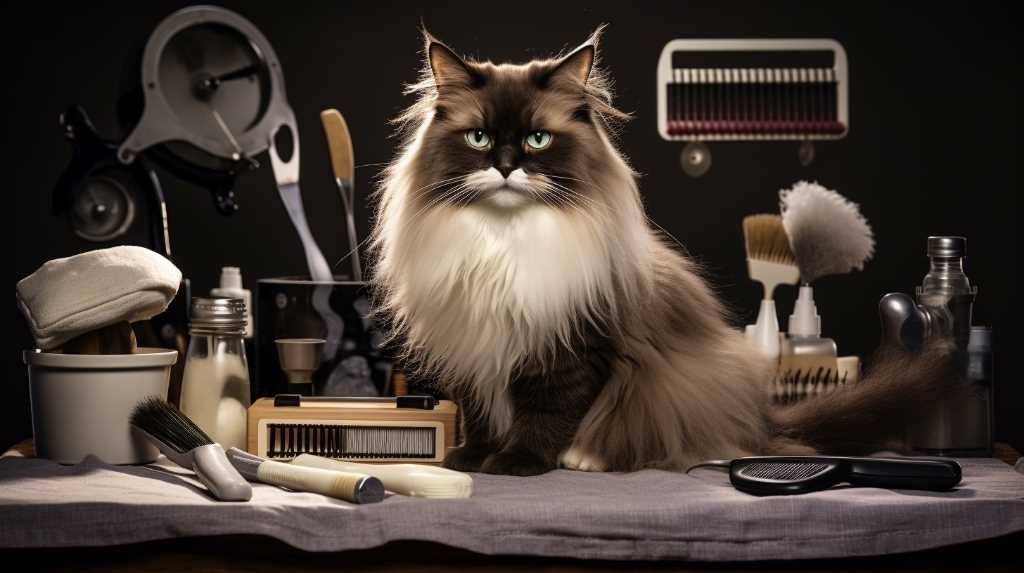
Consideration: Breeding Ojos Azules
To ensure the health and eye color of Ojos Azules, it’s important to work with reputable breeders who prioritize these aspects.
Consideration: Health considerations
Regular veterinary check-ups are necessary to monitor for potential genetic health issues in Ojos Azules cats. Responsible breeding and ongoing care are essential for their overall well-being.
Aphrodite
The Aphrodite breed is known for its elegant and graceful appearance. These cats have a long history and unique characteristics that set them apart from other feline companions. If you’re thinking about adding an Aphrodite cat to your family, here’s what you should know:
- History of Aphrodite Cats:
Originating from Cyprus, Aphrodite cats are believed to be descendants of the island’s ancient felines. People have cherished them for centuries due to their beauty and gentle nature. Legend has it that these cats were favored by the goddess Aphrodite herself, which adds to their mystique and appeal. - Unique Traits of Aphrodite Cats:
Aphrodite cats have strikingly large, almond-shaped eyes and a sleek, muscular build, giving them an air of elegance. Their plush, semi-long fur comes in various colors, enhancing their enchanting appearance. These cats are known for being affectionate and loyal, making them devoted companions and often seen as a symbol of good luck.
Considering the rich history and captivating traits of Aphrodite cats, it’s no wonder they hold a special place in the hearts of those seeking a graceful and loving feline companion.
Frequently Asked Questions
How Do You Know if a Cat Is a Mix of Two Different Breeds?
Determining if a cat is a mix of two different breeds can be done by observing their physical characteristics and behavior. One reliable method is genetic testing, which provides accurate information about breed-specific traits. However, analyzing their appearance and behavior can also give clues about their mixed heritage. By paying close attention to these factors, cat owners can gain insights into their feline friend’s unique ancestry.
Are There Any Health Concerns Specific to Any of These Lesser-Known Domestic Cat Breeds?
It is important to be aware of specific health concerns for lesser-known cat breeds. Due to their unique breeding history, genetic testing and health screening are crucial. Each breed can have its own potential health issues that require attention. By understanding these specific concerns, cat owners can better care for their pets and ensure their overall well-being.
What Are Some Unique Personality Traits Commonly Found in These Lesser-Known Domestic Cat Breeds?
If you’re curious about the unique behaviors of lesser-known domestic cat breeds, you’ll find that they have a wide range of personality traits. These breeds come from different backgrounds and display various social interactions and levels of intelligence. Some are known for their playful nature, while others have specific grooming habits. Understanding these distinct characteristics can help you appreciate the individuality of each breed.
Do Any of These Breeds Have Specific Dietary Needs or Restrictions?
Specific dietary needs and restrictions can vary among lesser-known domestic cat breeds. It’s important to understand that some breeds may require specialized diets and feeding guidelines to ensure their optimal health and well-being. Tailored nutrition plays a crucial role in supporting the unique needs of individual breeds. By providing the right diet, we can help our feline friends thrive and lead healthy lives.
Are There Any Specific Grooming Requirements for These Lesser-Known Domestic Cat Breeds?
Keeping these lesser-known domestic cat breeds looking their best requires regular grooming. It’s important to brush their coats regularly to manage shedding and maintain their overall health. Each breed may have specific grooming needs, so it’s advisable to consult a veterinarian for guidance if necessary. Taking care of their grooming needs ensures that these cats stay happy and healthy.
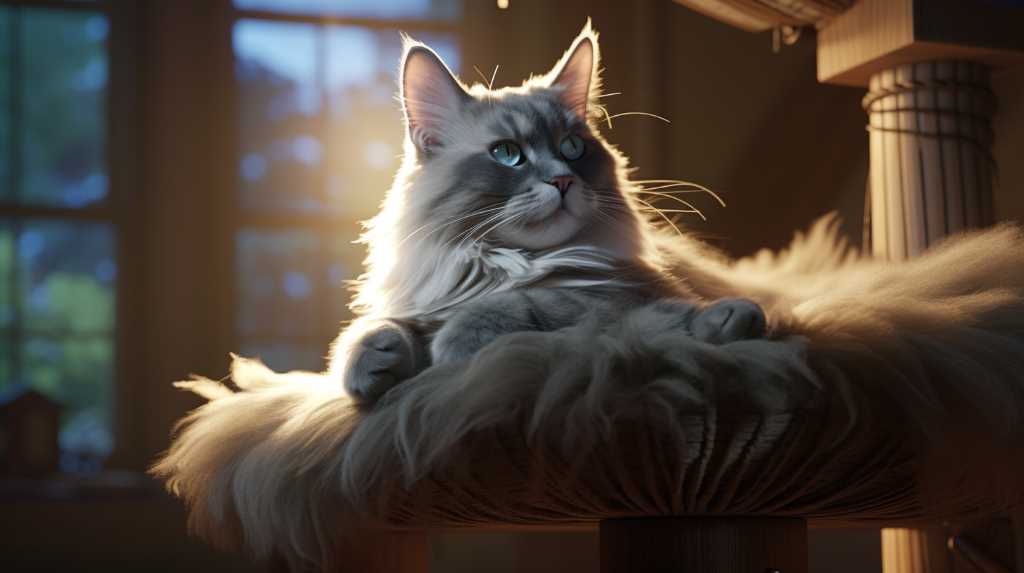
Conclusion
Uncover the Beauty of Lesser-Known Domestic Cat Breeds
You may be familiar with popular cat breeds like the Maine Coon or the Siamese, but there’s a whole world of lesser-known domestic cat breeds waiting to be discovered. These breeds may not be in the spotlight, but they offer a fascinating collection of diversity and charm.
One such breed is the Turkish Van, known for its majestic appearance and love for water. These cats have a unique story to tell, and their striking looks are sure to capture your attention.

Another lesser-known breed is the Minskin, which stands out for its adorable short legs and hairless body. Each breed has its own distinct features and qualities that make them truly special.
It’s important to remember that cats are more than just cute companions. They’re living beings with their own rich histories and characteristics. By exploring these lesser-known breeds, you can expand your understanding of feline beauty and the wide variety of cats that exist in the world.
So, next time you come across a cat, take a moment to appreciate the hidden gems of the feline world. You never know what treasures you might uncover when you keep an open mind and embrace the lesser-known breeds.
Cat Breeds
What Are Some Rare Domestic Cat Breeds?
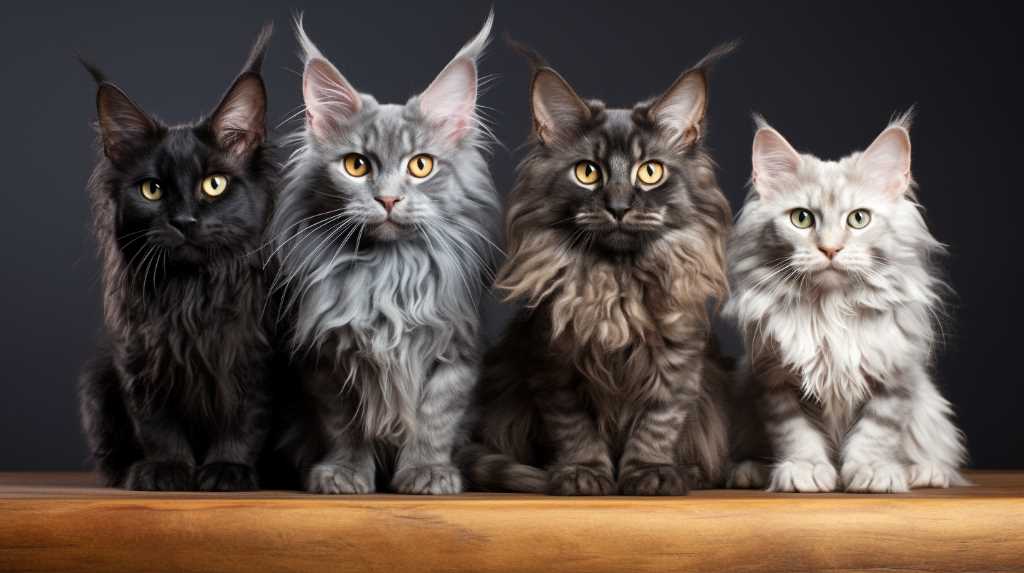
What Are Some Rare Domestic Cat Breeds?
Did you know that the world of domestic cats is incredibly diverse? There are some lesser-known cat breeds that are like hidden gems just waiting to be discovered.
Take, for example, the elegant Peterbald, a hairless wonder, or the adventurous Kurilian Bobtail, a wild hunter. These rare cat breeds offer a unique charm and companionship that you won’t find in more common breeds.
If you’re interested in exploring the fascinating world of rare cat breeds, get ready for an exciting journey! From the miniature cheetah-like Serengeti to the desert lynx-like Caracal, there are so many interesting and beautiful feline companions out there.
So why not discover a rare cat breed and add a touch of uniqueness to your home?
Key Takeaways
Now that you have learned about these rare domestic cat breeds, you may be feeling excited and eager to bring one into your home. These cats are truly special and have intriguing backgrounds that set them apart from other breeds.
Instead of opting for a typical cat, why not choose something extraordinary? Take this opportunity to find the perfect addition to your family and experience the companionship and joy they will bring into your life.
Peterbald: The Hairless Wonder
When it comes to rare domestic cat breeds, the Peterbald stands out as a truly unique feline. This breed originated in Russia in the mid-1990s through experimental breeding involving a Donskoy (Don Sphynx) and an Oriental Shorthair. What sets the Peterbald apart is its distinctive hairless or short coat, making it quite different from other domestic cats. However, it’s important to note that their lack of fur requires special care. Regular bathing is necessary to prevent oil buildup on their skin, and they also need protection from direct sunlight as they’re more prone to sunburn. Grooming plays a crucial role in their overall health and comfort, with a focus on keeping their ears and skin clean and moisturized.

As we transition to the next section about the ‘Kurilian Bobtail: The Wild Hunter,’ it’s worth mentioning that while the Peterbald requires specific grooming and care, the Kurilian Bobtail has its own unique needs and characteristics.
Kurilian Bobtail: The Wild Hunter
The Kurilian Bobtail is a rare domestic cat breed that originates from the Russian Far East. It’s known for its distinctive pom-pom tail and strong hunting instincts.
These cats are excellent hunters due to their agility, quickness, and keen sense of smell. Their physical features, such as their sturdy build, powerful hind legs, and bobbed tail, provide them with balance and agility during hunting.
The Kurilian Bobtail has a wild and untamed appearance, complemented by its striking eyes, which gives it the aura of a skilled predator. Their semi-long to long fur, often with a thick undercoat, helps protect them from the elements and allows them to thrive in different environments. Additionally, their distinct coat patterns and colors aid in their ability to blend into their surroundings, making them even more effective hunters.
If you’re seeking a feline companion with a strong natural instinct for hunting, the Kurilian Bobtail may be the perfect match for you.
Serengeti: The Miniature Cheetah
The Serengeti is a unique domestic cat breed that resembles a miniature cheetah. With their sleek and athletic build, they capture the grace and agility of their wild counterparts. If you’re in search of a feline companion that embodies the qualities of a wild predator, the Serengeti might be the perfect choice for you.
Known for their affectionate, playful, and energetic personality, Serengeti cats make wonderful companions for families or individuals seeking an active pet. When it comes to grooming, their short coat only requires occasional brushing to keep it healthy and sleek.
In addition to their personality, Serengeti cats are of moderate size and have strong exercise needs. They’re highly active and enjoy interactive play, so providing them with toys and engaging in play sessions is essential to meet their exercise requirements. Their athletic build contributes to their agility, making interactive playtime even more enjoyable for them.
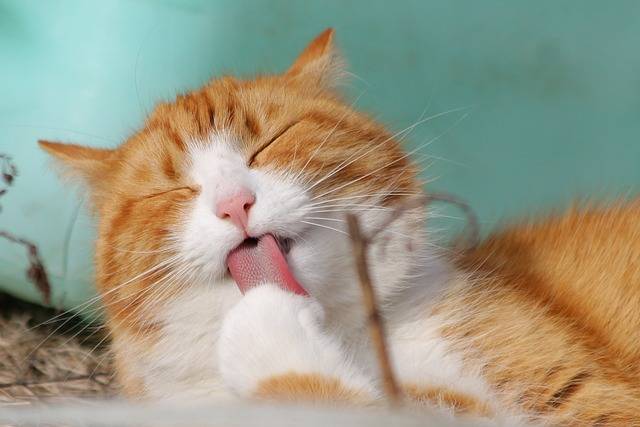
Caracal: The Desert Lynx
If you’re interested in a rare domestic cat breed that has the elegance and strength of a wild feline, the Caracal is worth considering. These cats are known for their impressive tufted ears and striking appearance. When you observe a Caracal, you’ll notice their graceful movements and powerful build, reminiscent of their larger wild relatives.
The behavior and hunting habits of Caracals reflect their agile and athletic nature, making them fascinating to watch as they stalk their prey with precision and speed. It’s crucial to protect the conservation and habitat of Caracals to ensure the survival of these magnificent cats in the wild. They’re facing threats from habitat loss and human-wildlife conflict. Efforts to safeguard their natural habitats and prevent illegal wildlife trade are essential for preserving this majestic species.
As you explore the world of rare domestic cat breeds, the Caracal stands out as a testament to the untamed beauty and strength of the wild. Now, let’s move on to the next rare domestic cat breed, the Sokoke: the African beauty.
Sokoke: The African Beauty
If you’re looking for a rare domestic cat breed with a unique heritage, the Sokoke is worth considering. This striking feline has an interesting history and distinctive appearance.
The Sokoke breed can be traced back to the Arabuko-Sokoke Forest in Kenya, where it was first discovered in the 1970s. What sets the Sokoke apart from other domestic cat breeds is its unique coat pattern known as ‘African Tabby.’ This pattern consists of dark spots on a warm, light brown coat, giving it a wildcat-like appearance. The Sokoke also stands out with its sleek, muscular body and large ears.
If you’re fascinated by rare breeds with an intriguing background, the Sokoke might just be the perfect match for you. Its captivating history and distinctive appearance make it a standout choice for those seeking a truly unique feline companion.
Frequently Asked Questions
Are These Rare Domestic Cat Breeds Hypoallergenic?
Yes, there are certain rare cat breeds that are considered hypoallergenic. These breeds have varying grooming needs and shedding patterns, but in general, they require less maintenance compared to other breeds. It’s important to note that training methods and behavioral characteristics can also differ among these breeds. Therefore, it is recommended to conduct thorough research on specific breeds to find the best match for your needs and preferences.
What Are the Average Lifespans of These Rare Domestic Cat Breeds?
The average lifespans of rare domestic cat breeds range from 12 to 18 years. These breeds may experience common health issues such as heart disease, dental problems, and obesity. To ensure your cat has a long and healthy life, it’s important to schedule regular vet check-ups and provide a balanced diet. Taking these steps will help you cherish your feline companion for years to come.
Do These Rare Domestic Cat Breeds Have Any Specific Health Concerns or Genetic Predispositions?
Rare domestic cat breeds may have specific health concerns or genetic predispositions. It’s important to understand their grooming needs, dietary requirements, exercise requirements, and common behavioral issues to ensure their overall well-being. Taking care of these unique cat breeds involves being knowledgeable about their specific health challenges and providing appropriate care and attention. By staying informed and attentive, you can help these rare cat breeds thrive and lead happy, healthy lives.
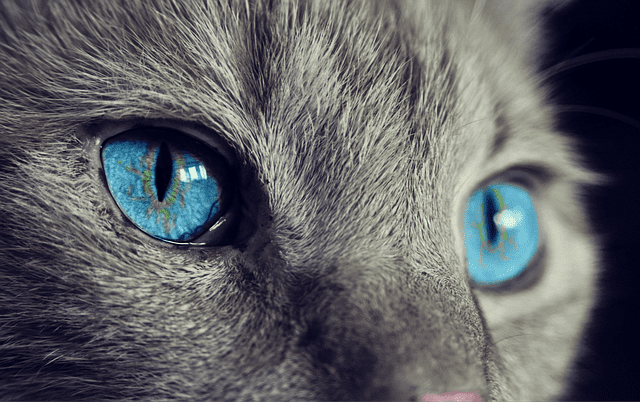
Are These Rare Domestic Cat Breeds Suitable for Families With Children or Other Pets?
When considering rare domestic cat breeds for your family, it’s important to focus on training methods and socialization techniques. Introducing pets and managing playtime require patience and consistency for a harmonious household dynamic. It’s crucial to train and socialize these cats properly to ensure they get along well with children and other pets. This will create a peaceful and loving environment for everyone involved. Remember, with the right approach and dedication, these rare cat breeds can make wonderful additions to your family.
What Are the Unique Personality Traits and Characteristics of These Rare Domestic Cat Breeds?
When exploring the unique personality traits and characteristics of rare domestic cat breeds, it’s important to consider their grooming needs, energy levels, and training requirements. Each breed has its own distinct qualities that set them apart. Understanding these traits can help cat owners provide the best care and companionship for their feline friends.
Conclusion
Now that you have discovered these rare domestic cat breeds, you may be feeling excited and eager to bring one into your home. These cats are truly unique and have fascinating backgrounds that make them stand out from the crowd.
Instead of settling for a typical cat, why not choose something extraordinary? Take the opportunity to find the perfect addition to your family and enjoy the companionship and joy they’ll bring into your life.
Cat Breeds
Discover Rare Domestic Cat Breeds With Our Guide
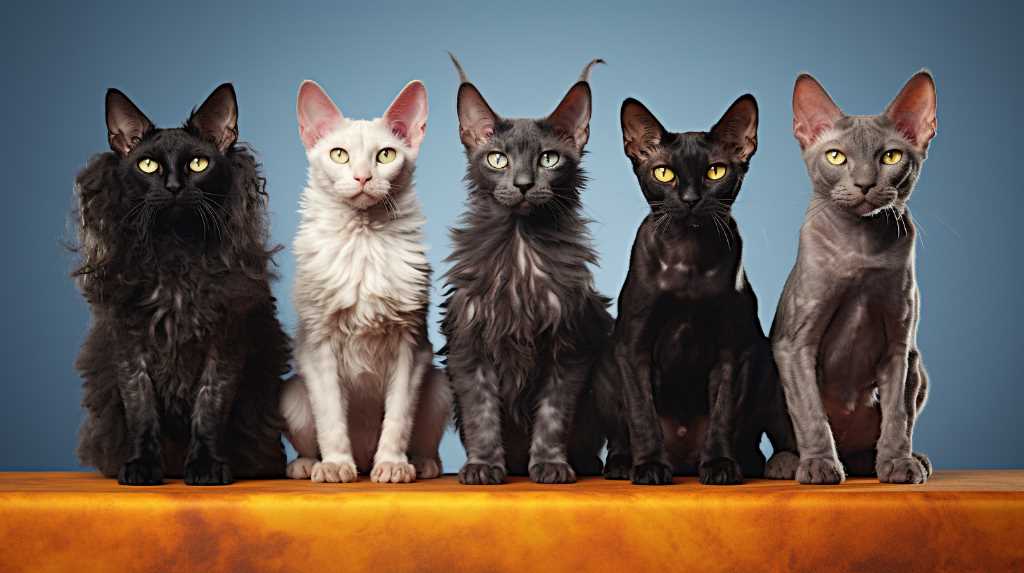
Discover Rare Domestic Cat Breeds With Our Guide
Explore the world of rare domestic cat breeds with our comprehensive guide.
You’ll discover unique felines like the Singapura, which holds the title for the smallest cat breed.
Another fascinating breed is the Korat, known for symbolizing good fortune.
Whether you’re a cat enthusiast or simply looking for a new addition to your family, our guide will introduce you to extraordinary breeds like the hairless wonder, Peterbald, and the curly coated LaPerm.
We’ll also shed light on lesser-known breeds such as the Turkish Van, which is famous for its remarkable swimming abilities.
Let us be your trusted companion as we navigate the realm of rare domestic cat breeds together, helping you find the perfect match for your home and heart.
Key Takeaways
Discover the fascinating world of rare domestic cat breeds, including the adorable Singapura and the curly-coated LaPerm. These unique feline companions are not only considered symbols of good luck but also bring joy and happiness to any home.
Each breed, from the hairless wonder of the Peterbald to the graceful Turkish Van, possesses its own special charm. These cats are known for their playful personalities and soothing purrs, making them the perfect addition to any family.

Experience the delight of these rare cat breeds and let them bring brightness to your days with their presence.
The Singapura: Smallest Cat Breed
Looking for a small cat breed? The Singapura might be the perfect choice for you. These cats are known for their small size, big eyes, and lively personalities. They’ve a compact and muscular body, large ears, and a unique ticked coat. Despite their small size, they’re energetic and love to play, making them a delightful addition to any household.
Taking care of a Singapura involves providing them with mental and physical stimulation. Interactive toys and regular playtime can help keep them happy and healthy. They also benefit from a nutritious diet to support their energy levels. Regular grooming is essential to keep their short coat in good condition.
Creating a safe and stimulating environment is crucial for these cats. With the right care and attention, the Singapura can bring joy and companionship to those looking for a small but spirited feline friend.
The Korat: A Symbol of Good Fortune
The Korat: A Symbol of Good Fortune
When it comes to rare domestic cat breeds, the Korat stands out as an intriguing choice due to its association with good luck. Originating from Thailand, the Korat is believed to bring blessings and prosperity to its owners. This unique breed is highly valued for its beautiful silver-blue coat and captivating green eyes.
Let’s explore some important aspects of the Korat:
Korat Origin and Significance: The Korat has a long and storied history that dates back to ancient Siam. In Thai culture, it was considered a symbol of good fortune and was often given as a cherished gift to bring luck and happiness to loved ones. This rich cultural significance adds to the allure and mystique of the Korat.
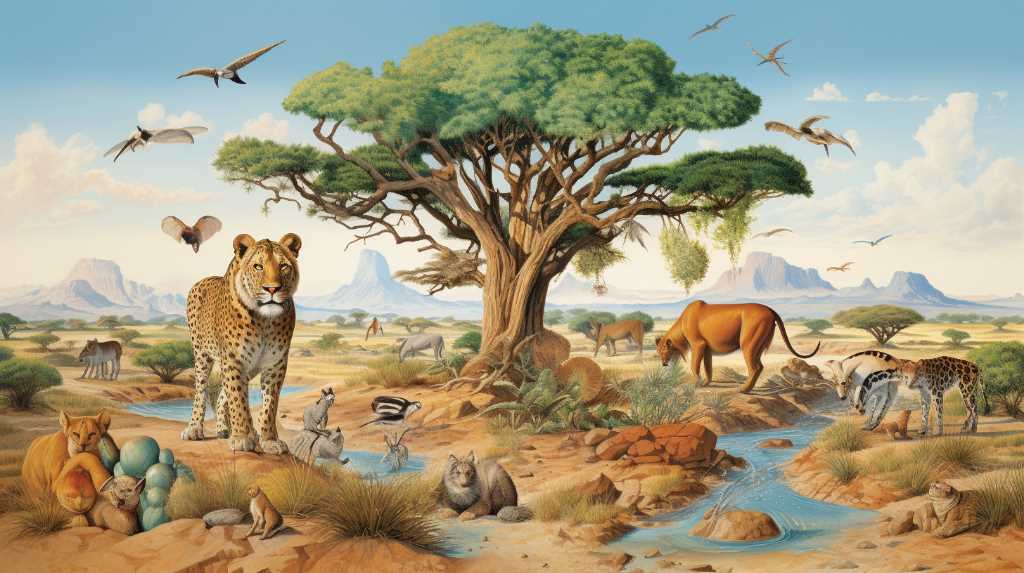
Korat Breeding Standards: Dedicated breeders adhere to strict standards to preserve the distinctive traits of the Korat. These include its heart-shaped head and double-layered coat. By maintaining these characteristics, each Korat maintains its unique appearance and lineage.
Korat Care: Known for their affectionate and loyal nature, Korats thrive on human companionship. Regular grooming is essential to keep their luxurious coat in top condition. They also enjoy interactive playtime, which helps keep them mentally and physically stimulated.
The association of the Korat with good fortune and its captivating beauty make it an appealing choice for cat enthusiasts who seek a meaningful and enchanting feline companion. As the saying goes, "A Korat by your side brings luck far and wide."
The Peterbald: A Hairless Wonder
The Peterbald, a rare domestic cat breed, is known for its unique hairless appearance, which sets it apart from the luxurious coat of the Korat. If you’re thinking about adopting a Peterbald and are worried about grooming, don’t worry! These cats require minimal maintenance because they don’t have fur. However, it’s important to protect their exposed skin.
Just like you have a skincare routine, these delightful felines need regular sunscreen application to shield them from harmful UV rays. They can also be prone to dry skin due to their lack of hair, so moisturizing with a pet-safe lotion is essential.
When it comes to allergies, the Peterbald is often considered hypoallergenic, making them a great choice for cat lovers who are sensitive to pet dander. Because they shed very little, there are fewer allergens in the environment. While no cat can be completely hypoallergenic, the Peterbald’s unique coat often causes fewer allergic reactions in people.
With the right skincare routine and attention to their grooming needs, the Peterbald can thrive in your care, bringing joy and companionship to your home.
The LaPerm: A Curly Coated Cat
Looking to add a special cat to your family? Consider the LaPerm, a charming breed known for its curly coat and affectionate nature. Here are some important points to keep in mind:

- Genetics behind: The LaPerm’s curly coat is a result of a genetic mutation that affects their hair follicles, giving them their unique wavy or curly fur. This genetic trait makes them stand out from other cats and adds an intriguing element to any home.
- Grooming tips: Despite their curly coats, LaPerms are surprisingly easy to care for. Their soft, curly fur rarely gets tangled or matted, so a gentle brushing once a week is usually sufficient to keep their coats in great condition. It’s also important to regularly trim their nails and take care of their dental hygiene for their overall well-being.
- Affectionate companions: LaPerms are known for their loving and affectionate nature. They enjoy being around their human companions and are often described as friendly, outgoing, and social cats. They make a great choice for families or individuals looking for a loyal and loving companion.
Transitioning to the next section about ‘the Turkish Van: The Swimming Cat,’ you’ll discover another fascinating and rare cat breed known for its unique swimming abilities.
The Turkish Van: The Swimming Cat
The Turkish Van Cat: A Remarkable Swimmer
Discover the exceptional swimming abilities of the Turkish Van cat breed with our informative guide. Unlike most domestic cats, the Turkish Van possesses a rare talent for swimming. These feline athletes have a natural affinity for water, making them exceptional swimmers. Their unique coat pattern, which is water-resistant and dries quickly, contributes to their love for swimming.
With a soft and silky semi-longhaired coat that resembles cashmere, the Turkish Van showcases a striking color pattern primarily on the head and tail, while the rest of the body is often white. This combination of water-loving behavior and stunning coat pattern truly sets the Turkish Van apart, making it a fascinating and special breed.
If you’re in search of a cat that enjoys water and boasts a one-of-a-kind coat, the Turkish Van could be the perfect fit for you. Not only are these cats beautiful, but they also possess an extraordinary talent for swimming, which adds a unique and delightful element to any cat-loving household.
Frequently Asked Questions
Are These Rare Domestic Cat Breeds Hypoallergenic?
Yes, some rare domestic cat breeds are hypoallergenic, but it varies. When considering hypoallergenic cats, it’s important to take into account their grooming requirements and shedding tendencies. Certain breeds may require less grooming and shed less, making them more suitable for individuals with allergies. Additionally, it’s worth considering their exercise needs and adaptability to ensure they will fit well into your lifestyle. It’s always a good idea to consult with a veterinarian or cat breed expert to determine which hypoallergenic breed may be the best fit for you.
What Are the Average Lifespans of These Rare Domestic Cat Breeds?
The rare domestic cat breeds have varying average lifespans. However, by providing proper care, grooming, exercise, and environmental enrichment, you can contribute to your feline companion’s long and healthy life. It’s important to understand their specific needs and be proactive in addressing common health issues. By doing so, you can ensure that your cat thrives for years to come. Remember, every cat is unique, and individual care and attention are crucial for their well-being.
Do These Cat Breeds Have Specific Dietary Requirements or Health Concerns?
When it comes to these unique domestic cat breeds, they have specific dietary needs and health concerns, as well as their own grooming and exercise requirements. It’s important to understand these factors to ensure their overall well-being.
Are These Cat Breeds Known for Certain Behavioral Traits or Personalities?
Certainly, these uncommon domestic cat breeds are recognized for their distinct personality traits and differences in temperament. Their origins and breed history also contribute to their unique behaviors, making them intriguing and delightful companions to have.

How Do These Rare Domestic Cat Breeds Interact With Children and Other Pets?
Rare domestic cat breeds have a great rapport with children, enjoying playful activities and building strong bonds. They can also get along well with other pets, but it’s important to introduce them early and socialize them properly with dogs and cats for successful interactions.
Conclusion
Explore the wonderful world of rare domestic cat breeds, including the adorable Singapura and the curly-coated LaPerm. These unique feline companions aren’t only a symbol of good luck but also bring joy and happiness to any home.
From the hairless wonder of the Peterbald to the graceful Turkish Van, each breed has its own special charm. These cats are known for their playful personalities and soothing purrs, making them the perfect addition to your family.
Experience the delight of these rare cat breeds and let them brighten your days with their presence.
Cat Breeds
What Are the Top Family-Friendly Domestic Cat Breeds?
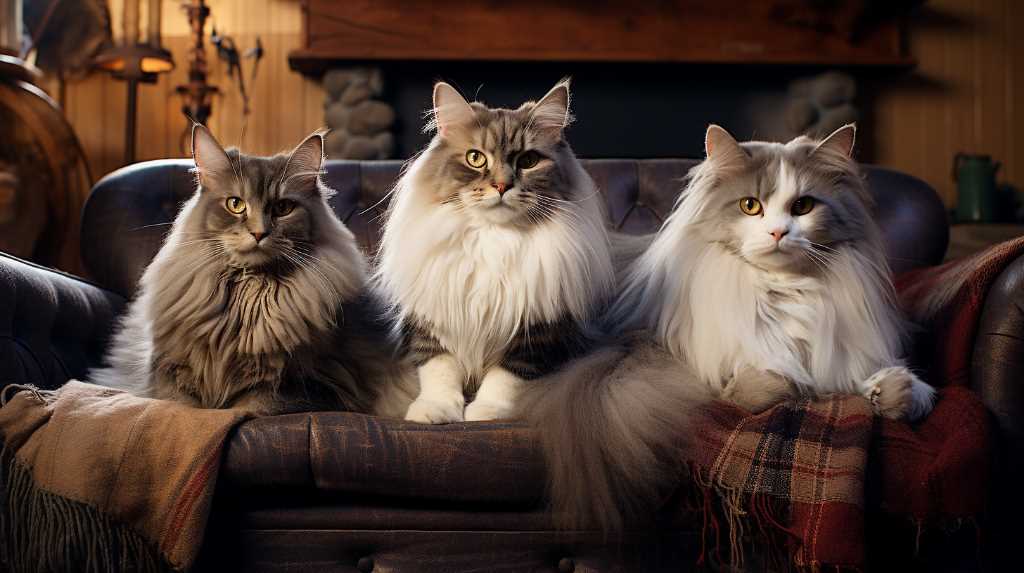
What Are the Top Family-Friendly Domestic Cat Breeds?
Curious about which cat breeds are best for families? Wondering if some cats are more suitable for kids? You’ve come to the right place! Finding the perfect cat companion for your family can be a rewarding experience. Understanding the characteristics of different cat breeds can help you make the best choice for your household.
In this guide, we’ll explore the top domestic cat breeds that are family-friendly and discuss their unique traits. Whether you’re interested in a gentle giant like the Maine Coon or an affectionate companion like the Ragdoll, we’ll help you navigate the process of choosing the right cat breed for your family.
Key Takeaways
Choosing the right cat breed for your family is an important decision. Understanding the characteristics and traits of different breeds can help you make an informed choice. There are several family-friendly cat breeds that you can consider. One such breed is the Maine Coon, known for its gentle nature and large size. Another option is the Ragdoll, a breed known for its affectionate and calm temperament. By selecting a cat breed that suits your family’s needs, you can ensure a harmonious and loving relationship for many years to come.
Understanding Domestic Cat Breeds
Understanding Different Domestic Cat Breeds
If you’ve ever been curious about how to distinguish between different domestic cat breeds, you can start by observing their physical characteristics and behaviors. By understanding cat behavior and breed-specific traits, you can easily identify and differentiate between various domestic cat breeds. Each breed has its own unique traits that have been carefully developed over time.
Domestic cat breeds have diverse origins, and their breed standards are based on specific physical attributes, such as coat length, color, and body shape, as well as behavioral characteristics. For instance, the Maine Coon is known for being sociable and friendly, while the Siamese is recognized for its vocal and affectionate personality. These breed-specific traits have been selectively bred for generations to create cats that fulfill specific roles within a household.
By familiarizing yourself with the history and breed standards of domestic cat breeds, you can gain a deeper appreciation for the distinctive qualities of each breed. By observing these traits and characteristics, you can easily identify and understand the differences between various domestic cat breeds, making it easier to choose the right cat for your family.
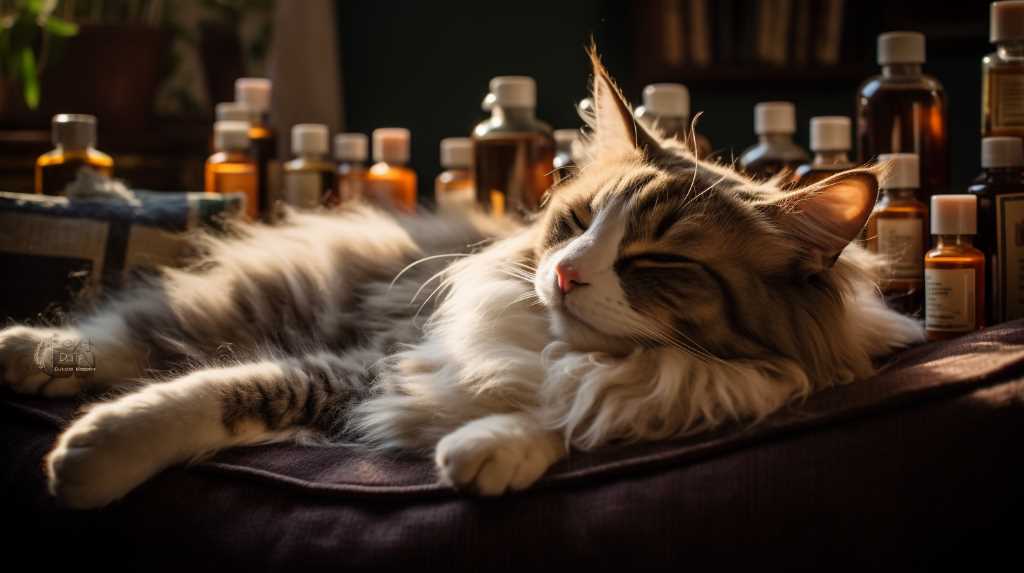
Quote: ‘Each domestic cat breed is unique, with its own set of physical and behavioral traits that make them truly special.’
Characteristics of Family-Friendly Cats
When considering which cat breeds are well-suited for households with children and other pets, it’s important to look at specific traits and behaviors. One key characteristic of family-friendly cats is their child-friendly behavior. These cats have a gentle and patient nature, making them great companions for families with young children. They’re tolerant of being handled and are less likely to scratch or bite when provoked, creating a safer environment for kids.
In addition to their child-friendly behavior, family-friendly cats often require low maintenance care. This means they’re generally easy to care for and can adapt well to the busy schedules of families. They may have a laid-back demeanor and enjoy lounging around the house, needing minimal grooming and attention compared to more high-maintenance breeds. This makes them a great choice for families looking for a pet that can easily fit into their lifestyle without requiring excessive time and effort.
Understanding these characteristics can help families make informed decisions when choosing a cat breed that will harmoniously fit into their household.
The Maine Coon: Gentle Giants
The Maine Coon cat breed is beloved for its large size and friendly nature, making it a popular choice for families in search of an affectionate feline companion. These cats truly live up to their reputation as gentle giants, as they’re among the largest domesticated breeds. Male Maine Coons can weigh between 13-18 pounds, while females typically range from 8-12 pounds, with some individuals weighing even more. However, it’s not just their size that sets them apart.
Maine Coons are known for their intelligence, gentle temperament, and adaptability, making them excellent companions for both families and individuals. Their friendly disposition and sociable nature make them great with children and other pets. They thrive on human interaction and enjoy being part of family activities, making them well-suited for indoor living.
In addition to their impressive size, Maine Coons have a majestic appearance thanks to their thick, water-repellent coat and tufted ears. This adds to their overall charm and appeal.
If you’re seeking a loving and sociable feline companion, the Maine Coon is an excellent choice. Their gentle and friendly nature, coupled with their impressive size, make them a perfect addition to any household.

The Ragdoll: Affectionate Companions
Consider adding a Ragdoll cat to your family for a loving and affectionate companion. Ragdolls are known for their gentle and sociable nature, making them great for families. Here are some important things to know about caring for a Ragdoll:
- Temperament: Ragdolls have a reputation for being gentle and affectionate. They’re often compared to dogs because they like to follow their human family members around and greet them at the door. Their calm and easygoing demeanor makes them a good fit for families with kids and other pets.
- Care Requirements: Ragdolls have semi-long, silky fur that needs regular grooming to prevent matting. Brushing them a few times a week can help reduce shedding and maintain a healthy coat. They’re also prone to dental issues, so it’s important to take care of their teeth. Due to their trusting nature, Ragdolls should be kept indoors to keep them safe.
- Social Needs: Ragdolls thrive on companionship and shouldn’t be left alone for long periods. They enjoy interactive play and human interaction, which makes them an ideal choice for families looking for a loving and devoted feline companion.
Choosing the Right Cat Breed for Your Family
Choosing the Right Cat Breed for Your Family
Finding the perfect cat breed for your family involves considering the specific needs and temperament of each breed, ensuring a harmonious fit with your lifestyle. It’s important to think about how the breed’s characteristics align with your family’s activity level and living situation.
When selecting a breed, it’s crucial to consider their temperament. For families with children, look for breeds known for being gentle and tolerant, such as Ragdolls or Maine Coons. If you have a busy schedule, consider low-maintenance breeds like the British Shorthair or Russian Blue, which are known for their independent nature. On the other hand, if you’re looking for an active and playful cat, breeds like the Abyssinian or Siamese could be a great match.
It’s also important to take into account any allergies within the family, as certain breeds are more hypoallergenic than others. Additionally, consider the available space in your home; some breeds, like the Bengal or the Savannah, are more energetic and require ample room to roam and play.
Frequently Asked Questions
What Are the Common Health Issues Associated With Family-Friendly Cat Breeds?
When considering cat breeds that are suitable for families, it’s important to be aware of their genetic predispositions and the common health issues they may face. Understanding their dietary needs and exercise requirements is also crucial for ensuring their overall well-being. By taking these factors into consideration, you can provide the best care for your family-friendly cat and help them live a healthy and happy life.
Are There Any Specific Grooming Requirements for These Domestic Cat Breeds?
Grooming is an important aspect of caring for domestic cat breeds. Regular brushing is necessary to keep their coats well-maintained and to control shedding. For short-haired breeds, a weekly brushing session is sufficient, while long-haired breeds require daily grooming to prevent mats and tangles. Bathing should be done as needed to keep their fur clean. By dedicating time to grooming, you can ensure that your cat’s coat stays healthy and beautiful.
How Do Family-Friendly Cat Breeds Typically Interact With Children and Other Pets?
How do cat breeds that are good with families typically interact with children and other pets? When it comes to training and socialization, the key is early exposure and positive reinforcement to address any potential challenges. It’s important to introduce these cat breeds to children and other pets at a young age, allowing them to become comfortable and familiar with each other. This helps to promote a positive and harmonious relationship within the family. Positive reinforcement, such as treats and praise, can be used to encourage good behavior and discourage any negative interactions. By following these best practices, families can create a loving and inclusive environment for both their children and their pets.
What Are Some Common Misconceptions About Family-Friendly Cat Breeds?
Common misconceptions about family-friendly cat breeds often arise from making generalizations. It’s important to recognize that each cat has unique behavior and personality traits. Cats can interact differently with children and other pets, so it’s essential to evaluate each cat individually. By understanding the specific characteristics of a cat, you can make an informed decision about whether it will be a good fit for your family.

Are There Any Unique Personality Traits or Behaviors That Family-Friendly Cat Breeds Are Known For?
When considering cat breeds that are suitable for families, it’s important to understand their unique personality traits, social behaviors, and ability to adapt. These cats often display affectionate, gentle, and playful characteristics, which make them perfect companions for family life. They enjoy interacting with their human family members and are known for their loving nature. Additionally, they are typically patient and tolerant, making them well-suited for households with children. These family-friendly cat breeds provide joy, companionship, and entertainment for the whole family.
Conclusion
When it comes to choosing a cat breed that’s suitable for families, it’s important to understand the characteristics and traits of different breeds.
There are many options available to fit your family’s needs, such as the gentle giant Maine Coon or the affectionate Ragdoll.
By carefully selecting the right cat breed for your family, you can ensure a harmonious and loving relationship for years to come.
-

 cats7 months ago
cats7 months agoHow to Get Your Cats to Stop… Everything You Hate: Every No Needs a Yes!
-

 All Animals1 year ago
All Animals1 year agoALL about Lagomorphs Explained!
-

 All Animals10 months ago
All Animals10 months agoExplore the Wilderness: ALL about Carnivores Unleashed!
-

 Animals1 year ago
Animals1 year agoThe Wonders: ALL About Artiodactyls
-

 Cat Breeds6 months ago
Cat Breeds6 months agoWhat Are Some Rare Domestic Cat Breeds?
-

 Cat Breeds6 months ago
Cat Breeds6 months agoWhat Are the Top Family-Friendly Domestic Cat Breeds?
-

 Cat Breeds6 months ago
Cat Breeds6 months agoDiscover Rare Domestic Cat Breeds With Our Guide
-

 Cat Breeds6 months ago
Cat Breeds6 months agoTop Family-Friendly Domestic Cat Breeds
